One of the more difficult tactical situations that arises during SCA rapier melees is the limited front. These typically take the form of doorways that must be breached in order to capture objectives and they are often the source of frustration, especially in larger melees such as the Siege of LaRochelle at Pennsic. The conventional wisdom for how to fight over limited fronts is as follows:
Defender:
The typical defense of a limited front involves the creation of a “killing cup” inside the door-way that forces attacking fighters to pass into the threshold of the doorway in order to engage the defenders.
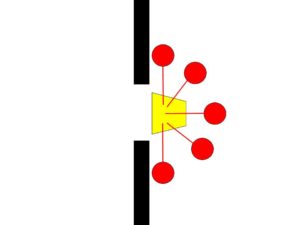
A killing cup inside a doorway. All of the defenders weapons threaten the entryway (shown in yellow).
Attacker:
The typical method for assaulting a limited front borrows heavily from the military and is frequently set up to mimic a door breach situation. In its simplest form, the conventional SCA wisdom for assaulting a killing cup consists of performing a “column charge” against one of the flanks of the defender’s killing cup.
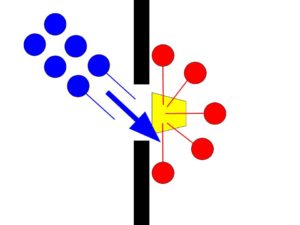
A column charge against the edges of the killing cup. Typically one side moves forward while the other screens their advance.
This Approach to Attacking Doesn’t Work:
I would contest that the conventional wisdom of using a column charge to attack a killing cup is completely wrong. Succeeding at such an attack requires a significant degree of coordination and training that is simply lacking in SCA melee units. Professional militaries and police forces are able to perform such actions because they’re professionally trained to do so. Even then, we see that militaries and police forces make use of substantial force multipliers such as body armor, flash bang grenades, and surprise, which are not available to SCA combattants (rhino-hiding doesn’t count). Furthermore, each individual fighter must trust that the other members of their unit also know how to perform the column charge. If even a single member of the unit lacks this knowledge, the attack isn’t possible. When we consider the melee skill level of the typical SCA rapier fighter, we can see how these criteria are difficult if not impossible to meet outside of certain specific melee units. These problems are compounded when we are considering the skill level of kingdom armies at inter-kingdom wars such as Pennsic and Gulf Wars where many of the fighters on the field only put on their mask once a year at those events.
Practical limitations aside, I would also argue that tactically the column charge method for attacking a killing cup is a bad plan. In a limited front engagement, the defender is placed at a (sometimes significant) advantage by the terrain and so in order for the attacker to win, they must either mitigate this advantage or must have an overwhelming advantage in some other way (usually numbers but sometimes skill). The column charge approach does not mitigate the terrain advantage of the defender. Notably, when fighters are killed during the column charge, they further limit the size of the opening, increasing the defenders’ advantage. Instead, making the column charge works only if the attacking force has greater numbers or greater skill, which ultimately suggests that it is tactically unsound.
Therefore an ideal method for attacking a killing cup must:
- Be simple enough for melee novices to perform with minimal training
- Eliminate the terrain advantage of the defenders
A Better Method for Attacking The Killing Cup:
To that end I propose that the best method for attacking a killing cup is to treat the limited front as a short line engagement at light engagement.
In this model, the attacking force approaches the doorway in as long a line as will fit through the doorway (Often no more than 2-3). Extra fighters should remain in reserve to replace losses and follow through on the attack. However, rather than charging aggressively into the killing cup, these fighters should approach only up until they reach the point where they are in light engagement with the fighters forming the flanks of the killing cup. This prevents the defenders who are deeper into the cup from being able to attack and helps to alleviate the numerical advantage provided by the killing cup. The attackers should then work on killing the fighters on the flanks and once a sufficient advantage is achieved, should press through the doorway decisively.
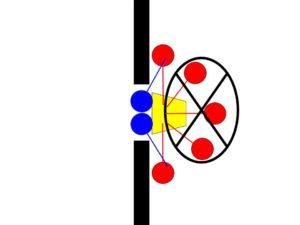
By refusing to enter the “kill zone” (in yellow), the attacking force removes the defenders in the center of the cup from the engagement. In this example, this eliminates the numeric advantage held by the defenders.
The key advantages to this approach are:
- It requires no special training. The methods used for attacking the killing cup are the same as the methods used in an open field line fight.
- It mitigates the terrain advantage provided by the “walls” surrounding the limited front by treating them as a continuation of a line fight infinitely in either direction (as is common to assume when trying to teach small numbers of fighters to perform a line fight in the first place).
- Limited front engagements benefit the unit with fewer fighters. In certain circumstances, this approach can mitigate a numeric advantage in favor of the defenders because it keeps the defenders at the center of the killing cup from being involved in the fight.
- In a battle with limited resurrections or limited numbers, this attrition method should result in fewer losses for the attacker.
The main disadvantage to this approach is that it is relatively slow and if the defenders can reinforce at the same rate (or faster) than the attackers can kill them, they can prevent the attackers from making any progress.
Bonus Material – Defending with Melee Novices:
For the most part, the current approach to defending a limited front is correct. The “killing cup” is the best strategy. However, putting this into practice for less-skilled fighters can be tricky and requires that you optimize your usage of the defensive terrain (i.e. the wall). The key details of doing so are as follows:
- The defenders weapons should meet in the middle of the inside of the doorway. This creates a place where attackers must deal with multiple weapon points.
- The defenders should be further away from the doorway than they think they should be. By standing further away, the defenders make themselves harder to kill and can rely on greater protection from the “wall” that forms the limited front. Attackers should need to enter the doorway in order to hit any of the defenders.
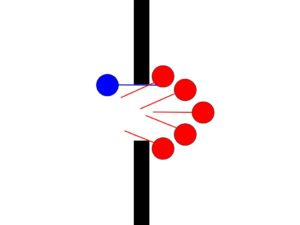
Here we can see that the defenders are standing too close to the doorway. This prevents the fighters on the ends from using the “wall” as a shield to protect themselves and places them at greater risk of being struck by the attackers.
- The cup should be formed from as few fighters as possible. Taking a doorway is difficult and the attacker’s numbers are limited by the width of the doorway. Forming a cup inside the doorway will always require more fighters than can fit through the door, so the minimum number required to create a cup will always have a numeric advantage. For example, a doorway that can fit 2 fighters at once will require ~4 defenders to form a decent cup providing a 2:1 advantage. Using more defenders than this is wasteful if they can be used more effectively elsewhere on the field.
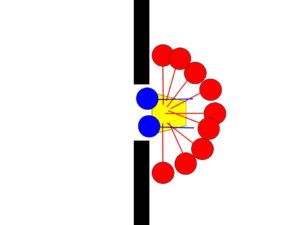
Here the defenders are using too many fighters to defend this doorway. Not only might this cause the defenders to obstruct each other, but it is also a waste of fighters. In this example, we can see a 9v2 numerical advantage on the part of the defenders where 3 or 4 v. 2 would be sufficient. Those fighters could be used elsewhere
If they cannot be used elsewhere, it is generally better to place them in reserve to fill holes in the cup rather than on the front line because this keeps them safe from “lucky” shots by attackers and keeps the defenders from getting packed too tightly to be effective.
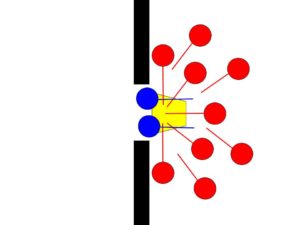
Rather than placing extra defenders in the cup directly, here we can see a way to build a second, reserve rank that can be used to replenish the cup as well as defend against more aggressive pushes that may bind the weapons of the front rank. This is a good option if those extra fighters cannot be used elsewhere on the field or when defending a particular doorway is absolutely essential.
There a couple of additional “optimizations” to consider. Good tactics shouldn’t rely on the characteristics of individual fighters, however certain arrangements of these characteristics can be beneficial. These details are secondary to the list above and can be ignored entirely in some circumstances (e.g. insufficient time to put into practice).
- The defenders closest to the wall should keep their off-hand side towards the wall if handedness allows. In other words, if you have a lefty, they should form the right flank of the defenders and a righty should be on the left flank. This will allow them more freedom to use their weapon.
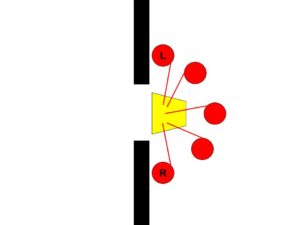
Here you can see how placing fighters with their off-hands towards the wall helps to keep their blade free.
- The flanking positions should be your most defensive fighters because the ends are the weakest points in the cup. In the cup format, the fighters on the flanks are in most danger of being struck because they’re closest to the attackers. They should expect to have their weapons bound up, smacked around, etc and that is okay. You may also consider placing fighters with long range and high offensive output in the center of the cup because they are least likely to have their weapons bound up, which will leave them more free to land attacks.
Finally, please note that an experienced and skilled unit that is working to defend a door-way will be more successful by taking a more offensive stance than what is recommended here. These recommendations are meant to allow a group of novices to use as much of the defensive advantage provided by the doorway as possible.
Pingback: Wistric
Pingback: Gawin
Pingback: Wistric
Pingback: Gawin
Pingback: Wistric
Pingback: Gawin
Pingback: Bobert
Pingback: Gawin